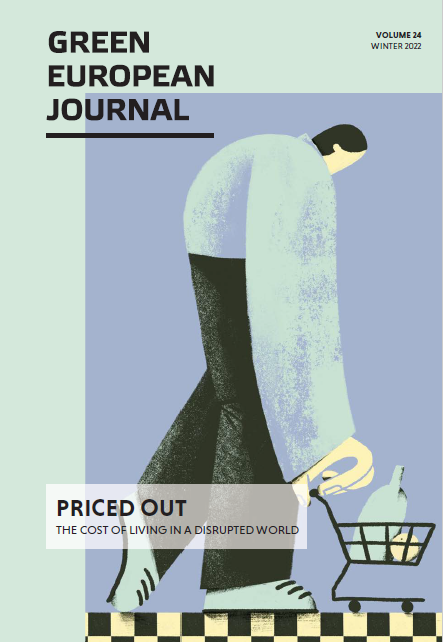Water privatization has catastrophic results, as shown by France and the United Kingdom. Citizens across Europe are increasingly opposed to the liberalization of essential services. But with climate change worsening droughts and heatwaves, public ownership is only the first step towards just and effective water management.
European policy has traditionally treated water as an abundant commodity to be extracted for profit. The severe droughts recently experienced in Europe indicate that this era of abundance is over and have brought home the true value of water as a precious and scarce resource. It is time to look at water in a new light.
This new situation requires a radical change in our approach to water policy and management. Former attempts to integrate water resources into the European single market now appear short-sighted at best and potentially disastrous. In order to build the resilience necessary to overcome the climate-related challenges ahead, we can no longer allow water to be exploited by market forces for private gain. The neoliberal water policies in place in many European countries need to be reversed, and water must be subject to public or commons-based governance. Only in this way can we build resilient water systems and keep water universally available and affordable.
Privatization and resistance
The current era of water privatization first began to emerge in the 1980s when, under the conservative rule of Margaret Thatcher, the UK government oversaw the transformation of water facilities into private assets. Water was privatized in England and Wales in 1989 as part of a wider liberalization agenda for public services and resources. Ten regional water authorities and their proprietary infrastructure were completely transferred to privately owned companies. As a result, water companies became ‘permanent regulated monopolies’, facing ‘public sector levels of competition and risk’ with ‘private sector levels of profit and return’.1
The result was a complete collapse in investment in water infrastructure with serious consequences for water losses. Private company Thames Water, which provides water to the London metropolitan area, has been criticized for its inability to deal with huge leaks from its pipes. The estimated water loss is 600 million litres per day – almost a quarter of all the water it supplies. This quickly becomes a severe problem in the context of drought-induced water scarcity. Thames Water and Southern Water, another large water and wastewater company, have also been criticized for unacceptable levels of sewage pollution and spills, which seriously affect both valuable ecosystems and public health.

Greenwich Park parched by the heat and lack of rain on 12 August 2022. Photo by Alisdare Hickson. Source: Wikimedia Commons.
In contrast, the privatization of water resources in France has a surprisingly long tradition, dating back to the mid-19th century. Here, privatization takes the form of public-private partnerships organised under lease or concession contracts. Municipalities regulate tariffs and remain the owners of the infrastructure. In other words, local governments retain responsibility for the infrastructure, while private companies take care of service delivery. In this way, control over the country’s water supply came to be held by a small number of companies that earn high profits and maintain monopoly positions while shouldering few of the costs.
In recent years, France has experienced a wave of re-municipalization following the expiration of contracts with major distributors Veolia Environnement, SUEZ, and Saur. Thus, while privatization in the UK consisted of the sale of the entire water system to private companies, in France it was achieved through concessions, which made it easier for municipalities to reclaim them.
The experiences of French cities such as Paris and Grenoble demonstrate the benefits of water re-municipalization. In 2010, Paris re-municipalized its water service from the hands of private companies including Veolia and SUEZ to create the public company Eau de Paris. The performance of Eau de Paris has been transformative: the price of water has been cut by 8 per cent and a new citizens’ commission was formed to enhance transparency and democratic governance.2
The new public utility created an active policy of water affordability for poorer households, migrants, and homeless people and increased the number of public water fountains. This success story was also a highly symbolic step that changed the national conversation around water in France. For its achievements, it was awarded the United Nations Public Service Award in 2017.
The years following the financial crisis of 2008 saw a major Europe-wide push to take water out of public ownership. Unsurprisingly, the water resources of Greece were among the targets. Amid the Eurozone debt crisis, the Greek public sector faced systematic pressure to privatize its two largest water companies in Thessaloniki and Athens – EYDAP and EYATH.
But these debt-driven attempts at water privatization were met with public resistance. A 2011 initiative led by the EYATH Workers’ Association eventually led to a March 2014 referendum at which an overwhelming majority (98 per cent of 218,000 voters) rejected the company’s privatization. While Greece provides the most striking examples of debt-driven attempts at water privatization, the practice is by no means limited to this country.
Privatization of water services is often set as one of the basic conditions of financial aid to indebted countries by international institutions such as the International Monetary Fund and the World Bank.3
Uniquely in the OECD, water use in Ireland is free up to a certain quantity and funded through general taxation. Similar to Greece, Ireland’s creditors pushed for an end to this policy amid the Eurozone crisis and the introduction of water charges in 2014. However, the move was met with strong resistance, including large demonstrations, a non-payment campaign, and civil disobedience in the active blocking of the installation of water meters. These tactics eventually led to the suspension of water charges in 2016. Today, Irish water resources are under the control of state-owned company Irish Water, which is accountable to the Commission for Regulation of Utilities and the Environmental Protection Agency.
In Italy, while none of the country’s regional water utilities are fully privatized, some are at least partially in private hands. The fact that most Italian water remains in public ownership is largely due to the 2011 referendum at which more than 55 per cent of voters opposed the attempts at water privatization that were also part of the larger austerity agenda that followed the financial crisis.
A tipping point: the Right2Water movement
Organized by the Italian Water Movement, Italy’s successful referendum became a rallying point against the liberalization of water and public utilities in general. It marked a landmark moment in the European movement against water privatization and eventually became the basis for the European Citizens’ Initiative Right2Water.4 A relatively underappreciated (non-binding) mechanism of direct democracy in the European legislative process, European Citizens’ Initiatives (ECIs) allow citizens to collect signatures to demand action on matters of EU competence.
The Right2Water petition was organized by the European Federation of Public Service Unions in 2012 and collected 1.9 million signatures across Europe, thus becoming the first successful ECI. Developing into a fully-edged social movement, it galvanized opposition to the European Commission’s tendency to push for water privatization across EU member states.
The initiative’s original demands were straightforward: universal accessibility and availability of water and sanitation provision in Europe and a halt to the privatization of water resources and the liberalization of services. Fulfilling such demands would effectively halt the neoliberal tendencies of European politics and the drive to make water a commodity to be exploited by market forces.
Over the 1990s and early 2000s, the privatization of water had come to be seen as necessary for the completion of the European single market. Arguments for the privatization of water were part of the broader neoliberal claim that once-public goods are best managed as private commodities. Both industry and investors tried to convince policy-makers and the public that handing over water services to private companies would increase investment in infrastructure, thus improving service quality and efficiency while ensuring price stability.
The Right2Water initiative, however, argued that privatizing public water utilities does not benefit users. The outcomes of water privatization in France and the UK were indisputable: water became more expensive, infrastructure investments were delayed, and the quality of service delivery stagnated. On top of that, the Right2Water movement contended, market-based solutions worsened water conflicts, jeopardizing both individual and collective water rights and exacerbating existing water inequities in the European Union.
In the face of this unprecedented public pressure, the European Commission eventually agreed that water was a public good rather than a commodity and excluded it from the Concession Directive, which is 2014 legislation opening up public procurement to greater competition. However, de-privatization policies remained unimplemented. Although the trend of water privatization was at least partially halted around Europe, it was not necessarily reversed to return privatized water infrastructure and services to public hands. This remains a task for the near future for reasons that go beyond those articulated by the Right2Water movement.
Building resilience
The rationale behind private water infrastructure ownership and resource management is that it generates revenues that can be reinvested into infrastructure, for instance to improve networks and prevent leakage. Predictably, this did not happen; rather, it simply made shareholders extremely wealthy. A 2020 investigation by The Guardian showed that, between 1991 and 2019, private water companies in England paid 57 billion pounds in dividends.5 That is nearly half the sum spent on infrastructure during the same period. Another dubious aspect of their financial performance was that they amassed debts of more than 48 billion pounds over the same period. Arriving at the conclusion that this mountain of borrowing was essentially used to channel money to shareholders does not require a huge leap of reasoning.
In the context of the climate crisis, earnings at this level are an unsustainable luxury we can no longer afford. Providing universal access to water will prove all the more difficult in the coming years as water becomes an increasingly scarce resource that needs to be distributed in a much more responsible and organized fashion. Our system of water management needs to adapt to the increased likelihood of droughts, heatwaves, and extreme weather events, manage risks, and cope with emergencies. This will require a coordinated approach.
Such a challenge needs to be met on multiple levels. First, Europe has a huge problem with water leaks caused by old, decaying pipes. This state of disrepair requires a strong political response in the form of massive investment in repairing and expanding water infrastructure. The private sector will not be willing (or simply cannot afford) to make these investments.

Coastal lagoon in the island of Kos (Greece) completely dry during the summer season. Photo by NinjaDriverInBrussels. Source: Wikimedia Commons.
Second, when water companies and infrastructure are publicly owned, imposing water restrictions during severe droughts becomes much easier. This partially answers the question of how to react to water emergencies in a coordinated and fair manner. While the market reacts to scarcity by increasing prices, when the public or a community owns and manages the water supply, this can help to keep prices from spiralling out of control. In the summer of 2022, the UK government pleaded with water providers for weeks to implement hosepipe bans but, given that they faced no legal obligation to do so, companies in some regions simply refused despite an official national emergency.
The problem with private water providers dealing with essential public goods is that they lack the principal accountability usually possessed by public or communal authorities. Their ultimate responsibility is to their shareholders, not their clients. Public or commons-based governance, in contrast, operates according to a different logic that puts people’s needs first.
Building water resilience in the context of accelerating climate change cannot be based on the socialization of losses and privatization of profits. Regardless of our best mitigation efforts, the climate will continue to warm for the next three decades at least. This will put severe pressure on our water resources. Within this new climate regime, water availability needs to become a matter of public security. This vital resource needs to be more governable, its price volatility reduced, its quality prioritized, and its use more regulated.
But it is not only water management and infrastructure that require additional investment; large-scale initiatives tackling landscape water retention are also crucial and must be supported. A good example in this regard is Czech grassroots movement Živá Voda (Living water), which focuses on direct interventions to restore water retention in the countryside through the revitalization of rivers and floodplains. The aim of these efforts is to restore the small water cycle, which has largely been disrupted due to the expansion of modern agriculture and soil exhaustion.
The much-needed implementation of similar projects across Europe, home to the highest number of shared water basins in the world, would necessarily go beyond national borders,6 requiring policies to be implemented at the European level. This could take the form of cross-border projects and cooperation or truly large-scale initiatives by the European Commission, which could provide the necessary legal framework. Water retention efforts, including an ambitious implementation strategy, should also become an important part of the EU Adaptation Strategy that guides European attempts to prepare for the effects of climate change.7
The success of the Right2Water movement is an inspiration for other grassroots initiatives. If done right, European citizens’ initiatives can shift the winds of European policy-making. This may prove useful for mitigating potentially harmful EU policies, but also for moving the European political discourse towards effective adaptation and resilience. If the European Commission can create directives for privatization, it can also create directives for re-municipalization and commons approaches that ensure that water is treated as a public good.
Although the de-privatization of water resources is an important step, it is evident that building a truly resilient future requires much more. Intelligent policy-making is essential; massive public investments into water infrastructure and water retention efforts will prove crucial in a situation of water scarcity, which may rapidly become the new normal for European countries. Rational risk-management of future crises and disasters requires that water is managed democratically to ensure that communities and society as a whole can effectively adapt to changing circumstances. Public and communal ownership of essential goods can provide the necessary basis for that resilience.
This article was first published by Green European Journal on 30 November 2022.
Jonathan Portes (2022). “I worked on the privatization of England’s water in 1989. It was an organised rip-off”. The Guardian. 16 August 2022.
Olivier Petitjean (2020). “Leaving Water Privatisation Behind: Paris, Grenoble and the advent of a water remunicipalisation movement in France”. Cities versus Multinationals – Passerelle, no. 20 (02/2020), pp. 128-136.
Maria Pempetzoglou & Zoi Patergiannaki (2017). 'Debt-driven water privatization: The case of Greece'. European Journal of Multidisciplinary Studies, Vol. 2 (Issue 5/May-August 2017), pp. 97-106.
The European Citizens’ Initiative (ECI) is a mechanism introduced by the Lisbon Treaty to allow citizens to put any issue on the European political agenda, provided at least 1 million signatures are collected within one year from at least seven different member countries.
Sandra Laville (2020). ‘England’s privatised water rms paid £57bn in dividends since 1991’. The Guardian. 1 July 2020.
Benoît Biteau (2022). ‘Droughts are a threat to peace in Europe – Why we need democratic water management in the EU’. Greens-EFA Blog. 14 September 2022.
The European Commission adopted its new EU strategy on adaptation to climate change on 24 February 2021.
Published 6 January 2023
Original in English
First published by Green European Journal (30 November 2022)
Contributed by Green European Journal © Martin Vrba / Green European Journal / Eurozine
PDF/PRINTIn collaboration with
In focal points
Newsletter
Subscribe to know what’s worth thinking about.
Related Articles

Democratic ‘Third Places’
dérive 10–12/2020
Urbanist magazine ‘dérive’ on emancipating Brazilian museology; the potential for Polish cultural centres; Swiss commons as a transferable prototype; and post-explosion Beirut.

Commoning the city
Reinventing togetherness
Instead of uniformity, commoning urban spaces offers an inclusive life, open to differences. Through self-managed initiatives, the ‘right to the city’ becomes the right to collectively produce it through creative cooperation.







